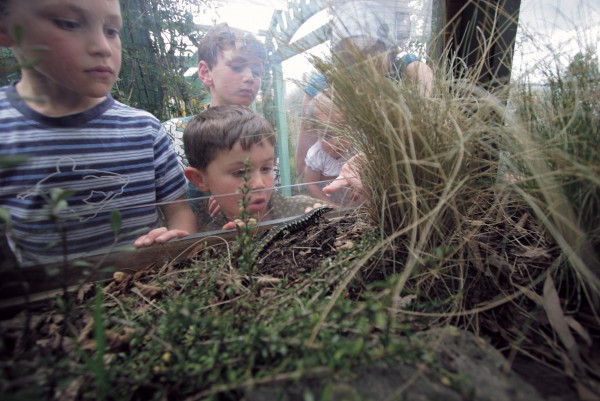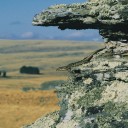
Near-extinct skinks
Two of our largest and most handsome lizards—the 30 cm long Otago and grand skinks from Central Otago—are staring at extinction unless present conservation efforts succeed.
Lizards, although as characteristic of New Zealand as birds— and, like them, unique—receive far less attention, despite the fact that there are more than twice as many endemic reptile species as endemic bird species in the country. Furthermore, some lizards are just as endangered as the rarer birds. Many of us could probably comment with some truth, “Our garden used to be full of lizards, but we haven’t seen any for years.”
New Zealand’s reptiles come in three forms. Best known is the tuatara, which, while it isn’t a dinosaur, has ancestors that saw the time of the “terrible lizards” come and go. Then there are the geckos, the nocturnal Hoplodactylus and the diurnal Naultinus species. The latter are distinctive, having velvet, often bright-green skin, piercing, unblinking eyes and stout bodies. The third group is the skinks, resplendent with smooth, gleaming scales, long bodies and often surprisingly small limbs. Wandering sea snakes and turtles also wash up on New Zealand shores from time to time, but they don’t breed locally, it being too cool.
New Zealand’s skinks belong to one of two genera. Exclusive to the North Island are the rather mysterious, or at least unusual, Cyclodina skinks. Several species are nocturnal—not usual behaviour for skinks—and some are so elusive that the existence of a species may be known from only a handful of sightings. The other genus is Oligosoma, to which skinks of the South and Stewart Islands belong. In total there are more than 90 species of lizard in New Zealand, but nearly half still await formal description and naming. Many are cryptic, meaning it is very difficult to distinguish between them. Identification depends on knowing where a specimen was found and such minutiae as the number of scales on its toes.
- The gold marking of both grand and Otago skinks provide camouflage on the lichen-encrusted rock outcrops the two lizards inhabit. Otago skinks – here scrutinised by boys in an Alexandra captive breeding facility – have bolder blotches than grand skinks.
Two of the largest, most colourful species of skink—the grand and the Otago—can easily be identified thanks to their bold, almost mesmerising livery. Shiny black with bold blotches of gold, the Otago skink (Oligosoma otagense) can reach 30 cm in length and is a true giant among the country’s endemic skinks. It has a heavy-set body equipped with powerful limbs and strong claws, ideal for darting across its steep rocky habitat.
The grand skink (Oligosoma grande) is a little smaller and more svelte than the Otago, and its skin is peppered with tiny golden flecks on a black background. Like the Otago, it possesses strong, clawed limbs that enable it to make the most of its rocky habitat.
Both skinks are found only on deeply fissured schist tors or outcrops in Otago’s tussock country. Not only do tors offer excellent security, they also have useful thermal properties. Skinks, like all reptiles, are cold-blooded and regulate their body temperature through exposure to heat and cold in the environment. Bare rock exposed to the sun makes for ideal basking conditions, heat coming both from above and from the substrate. Fissures in the rock provide refuge from soaring temperatures in the summer and—since these species do not hibernate—freezing conditions in winter. The habit of not hibernating probably relates to the variability of Otago’s weather, for snow can fall even in summer, and winter has its sunny days.
Today, these giant skinks are lucky to reach five or six years of age in the wild, although in captivity they can live for more than 30 years. Since both species take more than four years to reach sexual maturity, this is a problem, because most will perish before reproducing. Once mature, they still produce only two offspring a year. Like all other New Zealand reptiles except the tuatara and the egg-laying Suter’s skink, the grand and Otago skinks are viviparous, giving birth to live young.
At least five other skink species and at least two gecko species are found in the same habitat as the giant skinks of Otago but these two are the most vulnerable. Surveys by the Wildlife Service (a precursor of DOC) showed that by the 1980s they were restricted to less than 10 per cent of their former range. Historically they extended throughout the once rich mosaic forest of broadleaf, kowhai, totara and bog pine, the Coprosma shrub country and the tussock grasslands of central Otago, from Middle-march in the east to Wanaka and Queenstown in the west.
Now both reptiles are classified as “critically endangered with extinction”, being largely restricted to the Macraes Flat and Middlemarch areas of east Otago, with a few very small populations in the west near Lake Hawea and the Lindis Pass. Their disappearance from much of their range went largely unnoticed until the 1970s. As human knowledge up to this time of even the most iconic New Zealand fauna, such as the kakapo, was somewhat patchy, it’s no surprise that lower-profile wildlife such as skinks went unnoticed.
Because these two skinks are confined to Otago, they are in some senses more emblematic of the region than is the northern royal albatross or the yellow-eyed penguin, both of which breed elsewhere. There are no suitably arid, mammal-free islands to which they can be translocated. On the positive side, however, they are winning growing support from the often parochial Otago public, who are starting to recognise them as icons of the harsh Grahame Sydneyesque wilderness that defines their province.
[chapter break]
With any decline in New Zealand fauna, predation is always a prime suspect. When the stomach contents of feral cats trapped in the tussock habitat of grand and Otago skinks are examined, anything up to 36 partly digested common and McCann’s skinks have been found. As such a tally represents only a few hours’ foraging, it’s hard to fathom how skinks have persisted at all. Evidence of potentially catastrophic feline predation inspired a six-year project to control the feral cat population in the 2400 ha Macraes Flat Grand and Otago Skink Reserve. Based in a historic farm cottage and equipped with humane Victor soft-jaw leg-hold traps, plenty of enthusiasm and an all-terrain vehicle, the operation was launched in the 1990s. Trappers endured snow, horizontal sleet and the cloying mist that shrouds the hills for much of the year to service hundreds of traps daily. Ecologists sweltered in temperatures over 30°C as they monitored the elusive reptiles. Despite this mammoth effort, during which hundreds of feral cats were trapped, skink populations showed no obvious signs of recovery; indeed, in most study sites there were further dramatic declines. Extinction looked an increasing likelihood.

The by-catch of the trapping programme made it clear that cats were not the only possible predators of skinks. Ferrets, stoats, weasels and the occasional rat were caught too, as were hundreds of hedgehogs. Long assumed to be benign creatures that did little more than hoover up slugs in suburban back yards, the spiny critters were filling up the trappers’ freezers, so students were given the odorous task of examining hedgehog stomach contents. Remains of both common and McCann’s skinks were found in 27 per cent of the stomachs opened. As with cats, no grand or Otago skink remains were found, but logic dictates that predators are unlikely to distinguish between common and rare lizards and that a larger sample would have revealed semi-digested grands and Otagos. The number of skinks eaten by any given hedgehog is likely to be underestimated: after a sound chewing, the only way to ascertain the number of skinks devoured is to count feet—which seem to survive munching—and divide by four.
Gut analysis of ferrets and stoats revealed that mustelids also feed on skinks in the tussock grasslands, as do rats. Mice are coming under increasing suspicion not only of predation but also of competition, since their omnivorous diet of invertebrates, fruits and seeds overlaps the skinks’. Both the grand and Otago skink are omnivorous, eating invertebrates and the fruits of native shrubs and other plants.
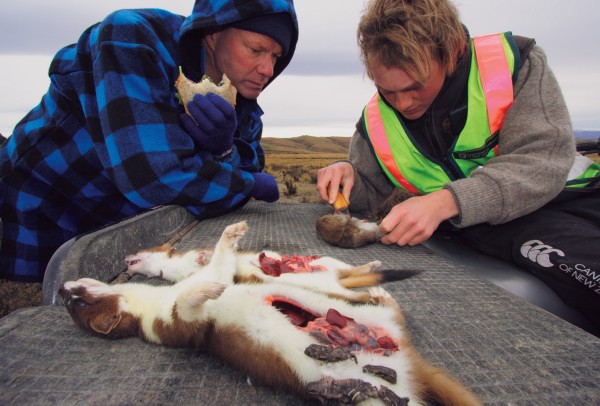
Flies and beetles make up a large proportion of their invertebrate consumption: both species can often be observed snapping up flies warming themselves on the lichen that encrusts the schist tors. When gleaming manuka beetles congregate to reproduce, the scats of the skinks appear iridescent green because they contain so many fragments of manuka-beetle elytra.
Favoured fruits include the berries of Coprosma propinqua and various Gaultheria species. One of the most interesting fruits in the skink diet is that of Melicytus alpinus, sometimes known as the porcupine shrub. This species likes to hug the surface of the rocks between which it grows, and, being stoutly formed, offers excellent cover for basking and foraging skinks. It fruits along the underside of its branches, an area inaccessible to birds but ideal for lizards.
Grand and Otago skinks have been closely monitored now for nearly 15 years and a wealth of data on their biology has been collected, allowing the formulation of sound population-viability models. These indicate that both species will be functionally extinct in the wild by aproximately 2009 to 2012.
Key to the dynamics of skink predation in pasture and tussock grasslands is that the success and abundance of alien predators isn’t dependent on skink numbers, rather on the number of rabbits and, to a lesser extent, on rats, mice and hares. Research on the relationship between cats’ and mustelids’ primary prey (rabbits) and secondary prey (which includes skinks) by Landcare Research ecologist Dr Grant Norbury, has exposed the chilling reality that dwindling skink numbers have little or no effect on the extent to which predators target skinks. Skinks are, quite simply, dessert.
The predators of grand and Otago skinks aren’t limited to mammals, either. The New Zealand falcon, the Australasian harrier, magpies (from Australia) and the starling (from Europe) are all either known to dine on skinks or suspected of doing so. Although birds have picked off skinks for millennia, when populations plummet the combination of furry and feathered predators could prove terminal.
Mammals are deadly to skinks on two main counts: their keen sense of smell and their patience. Most birds don’t follow scent when seeking food, but a stoat, cat or hedgehog employs highly developed olfactory capabilities to sniff out a meal, such as a basking skink. For nocturnal hunter-foragers like hedgehogs and mustelids, digging out a sleeping skink from the base of a tussock is easy.
Patience is an asset ideally suited to ambush, a hunting technique in which cats are specialists. Upon sighting prey, a cat’s first reaction is to freeze. Even if a skink that has been spotted scuttles into the safety of a rock crevice, the cat will simply wait. Three or four minutes later, the skink pops its head back out into the sun, and snap!—feline morning tea.
Parasite infections among grand and Otago skinks are also thought to be on the rise. Although no direct health implications have been detected, the trend is a concern as it may signal a subtle deterioration in the skinks’ living environment. Infection with mites is suspected of inhibiting reproduction among captive animals.
Another potential nail in the giant skinks’ coffin is habitat. The preferred habitat of, say, kakapo or kiwi is known, and the key agents of decline have been identified—stoats and rats—and can be controlled. When it comes to preventing the extinction of such species, we may not be home and dry but we at least know what is required and can provide it if we have the will to do so.
With grand and Otago skinks this isn’t the case. In pre-human times, up to 800 years ago, much of Otago was covered in a mosaic of dryland forest and shrubland. Tussock, though present, didn’t dominate as it does today. Palaeobiologist Dr Richard Holdaway, at the University of Canterbury, has noted that the wellspring of biodiversity in New Zealand was the eastern South Island, not the deep forested valleys of the south and west that today hold the tattered remnants of the country’s bio-heritage.
Otago’s dryland vegetation didn’t survive the arrival of humans. Maori used fire to make both moa hunting and travelling easier. Extensive burning-off produced the wide-open tussock country that greeted the first Europeans to enter the region. The grand and Otago skinks’ response to this change isn’t known; nor is it known what their ecology and habitat were in the earlier environment, with its predominance of shrubs and trees.

European settlers arrived full of pioneering spirit and a lust for gold. Some saw the potential for farming and burned the tussock before sowing imported pasture grasses. Exotic plants now dominate much of the landscape. And where overgrazing and treading by sheep and cattle have opened the sward, Otago’s dry summers have powdered the topsoil and the wind has dispersed it, leaving the ground in such a poor state that in many areas only hardy weeds such as Hieracium survive. Drastically altered ecosystems have left native animals, including grand and Otago skinks, stuck between a rock and a very degraded place.
Even if we had a silver bullet for the instant eradication of predators, we haven’t a clue as to the habitat we should recreate for the endangered skinks. We don’t even know that where they persist is the best place for their conservation. It could be that where grand and Otago skinks are today isn’t where they’d prefer to be, or where historically they have flourished. Certainly they are now restricted to cooler, less productive montane areas than a century-and-a-half ago.
This is probably a consequence of the fact that when rodents and rabbits swept across Otago in the 1800s, they found more food and reached higher numbers in the more productive lowland areas than higher up. Then, as the populations of stoats, ferrets, cats and other predators boomed on the glut of rabbits and rodents, native secondary prey, including lizards, was hammered. Consequently, grand and Otago skinks disappeared from the most productive parts of their range, just as takahe vanished from beech forests and now survive in the wild only in isolated alpine tussock in Fiordland.
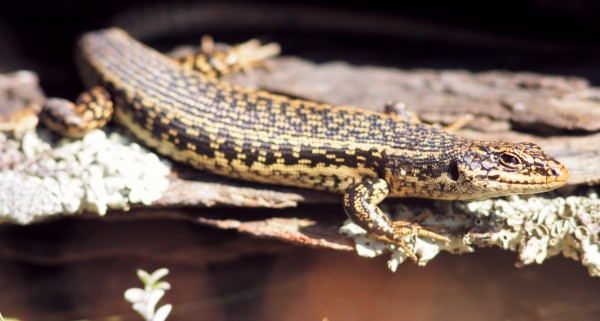
The skinks’ former homeland is now covered in high-quality pasture, vineyards or pest-infested thickets of briar and thyme. Research has shown that grand skinks move around less in developed pasture than in tussock country. To begin with, pasture offers less cover and fewer places to bolt when danger threatens. There is also less to eat. A significant part of the skinks’ diet consists of fruits from the little shrubs and herbs that grow among the tussocks and in the fissures of their schist-tor homes.
It is puzzling that grand and Otago skinks are disappearing while more common species in the same region seem to be holding their own. The explanation likely lies in the delayed sexual maturity and slow breeding of grands and Otagos.According to a recent article in Nature, these traits, which are shared by kakapo and tuatara, may have been the primary reason why moa were hunted to extinction
so rapidly by Maori.
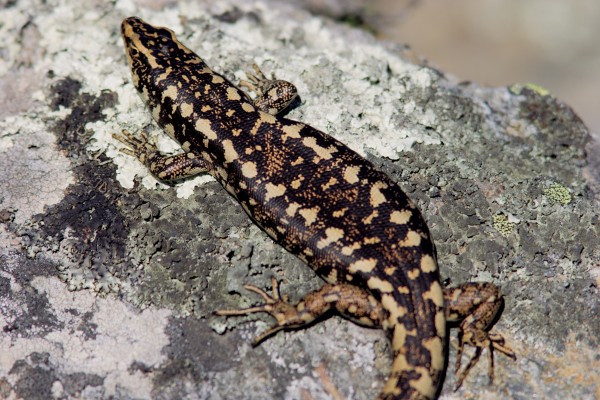
For a species under pressure from predators, taking four or five years to reach sexual maturity is a distinct handicap since there is little likelihood of surviving that long and thus of ever mating. If those that survive have only two offspring a year, they do little to remedy the situation. The commoner skinks mature earlier and produce more offspring than do grand and Otago skinks, thereby doing more to counter predator pressure. Not that there is room for complacency concerning these species. As more is learned about the size and distribution of skink populations in the wild, it becomes clear that even the most common species may be facing a less than rosy future.
[chapter break]
Like its approach to preventing the extinction of other New Zealand species, DOC’s efforts to save grand and Otago skinks have focused on controlling specific pests. Unfortunately, this hasn’t resulted in a recovery of skink numbers. New conservation techniques are required. The prediction that less than six years is all these two skinks have left if nothing is done is supported by data from population surveys conducted outside the protected areas between 1984 and 2002. These show that more than 50 per cent of sub-populations of both skinks have died out over the past 20 years. The total reserve land secured for these two species (approximately 2500ha) holds fewer than 2000 animals of each species and monitoring confirms only 400 Otago skinks and 800 grand skinks. Populations in the Lindis and Hawea areas are believed to be much smaller still, although access issues on some properties limit what is known. No more than five years remain in which to turn things around for these skinks—a heart-stoppingly close call considering it will be at least three years before a detectable response in any of the populations can be expected owing to the skinks’ slow maturation and low breeding rate.
Given the lack of time, picking the next most likely agent of decline, attempting to control it and waiting for a turn-around is not an option. Instead, the recovery-programme team has embarked upon a management experiment that entails the total exclusion of mammals from one small area and intensified conventional mammal control across a wider neighbouring area.
Over the past decade businesses such as the Xcluder Pest Proof Fencing Company have pioneered the design and construction of fences to keep everything from mice to cattle out of an area. For species that cannot be shifted to a pest-free island and are unable to adapt even to low numbers of mammals in their habitat, fencing may offer the last hope.
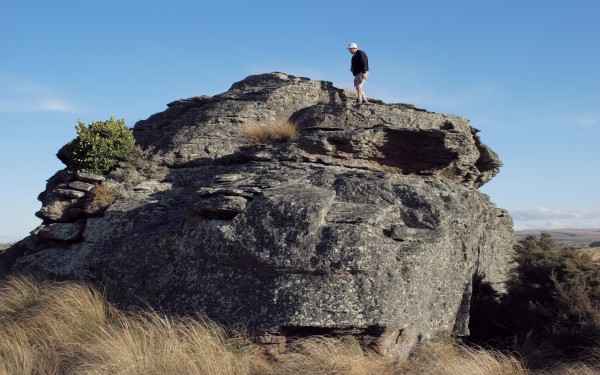
In May 2005 nearly two kilometres of mammal-proof fencing was erected round a population of Otago and grand skinks in the Macraes Flat reserve. Choosing a site was difficult, as with a limited budget and the high cost of the fencing it had to be small. It also had to include vacant space and spare resources for a growing population, whilst those skinks left outside the fence may be functionally extinct before any improvement is detected within. An added complication was that grand and Otago skinks have subtly different habitat preferences, both of which had to be catered for.
Near this mammal-proof exclosure is a 1200 ha area where previously employed predator-control techniques are being applied more intensively than in the past.
Both sites, together with non-treatment comparison sites outside the reserve, are the focus of some hi-tech skink-monitoring methods. Hundreds of high-resolution digital images stored in databases on laptop and palmtop computers allow the identification of individual skinks from their unique markings.
Because of the danger of imminent extinction, the recovery programme team has had to develop emergency captive-management techniques. Specially permitted captive breeders, or herpetoculturists, who have had some success in breeding the Otago skink in captivity, are now developing techniques to breed the grand skink. Captive management, however, is a last resort. The priority is to manage and protect the skinks in the wild.
[chapter break]
As New Zealand struggles to save a whole raft of endemic wildlife from extinction, where do grand and Otago skinks sit in the scheme of things? Given that to generate and maintain a sustainable population of these lizards will cost a consider- able sum, should investment in the recovery programme be in line with a biodiversity management strategy that optimises conservation gains per dollar invested in Otago? These are issues for DOC regionally and nationally. The establishment of a “mainland island” for these skinks and other species in Otago’s dry land is increasingly looking like the only option.
Getting the public to understand the plight of these unique creatures and their ecosystems is essential. Without public support, the skinks’ chances of survival are slim. Conservation is as much driven by public opinion as it is by political and strategic decisions. In New Zealand the situation is more pressing than just about anywhere else on the planet. Ecosystem collapse didn’t happen 5000 years ago or even 500 years ago in our isolated islands: it’s happening now, right in front of our eyes.
- The PM recently launched the Central Otago Ecological Trust which aims to re-establish these handsome lizards in the Alexandra district.
Fortunately for grand and Otago skinks and the dryland ecosystems of Otago, DOC no longer faces these problems alone. The challenge has recently been taken up by a group of conservationists in the Alexandra area representing business, science, agriculture and the community. Led by ecologist Grant Norbury, the Central Otago Ecological Trust (COET) aims to establish a refuge for the reintroduction of native species, called the Mokomoko Sanctuary. COET has identified some suitable habitat within Aldinga Conservation Area, near Conroys Dam. With the generous support of Alistair Campbell—a COET trustee and a farmer with a grazing concession in the area—the trust has begun planning the construction of a mammal-proof fence that will eventually protect a 24 ha area. Meanwhile, COET is working with the Grand and Otago Skink Recovery Programme to establish a small captive population of each species in Alexandra.
In November 2005 a formal Ngai Tahu welcome was held for the first Otago skinks to be returned to Alexandra. The species had been absent from the area for some 30 years. In recognition of the growing profile of, and concern for, Otago’s dwindling wildlife, Prime Minister Helen Clark officially launched COET, acknowledging that “The future of these skinks is in greater peril than that of the kiwi,” and adding that community involvement as exemplified by the trust was vital to success.
Despite all the work going on, the future of Otago’s giant skinks cannot be guaranteed. But the recovery programme and initiatives such as COET provide a basis for hope that they might once again flourish.







